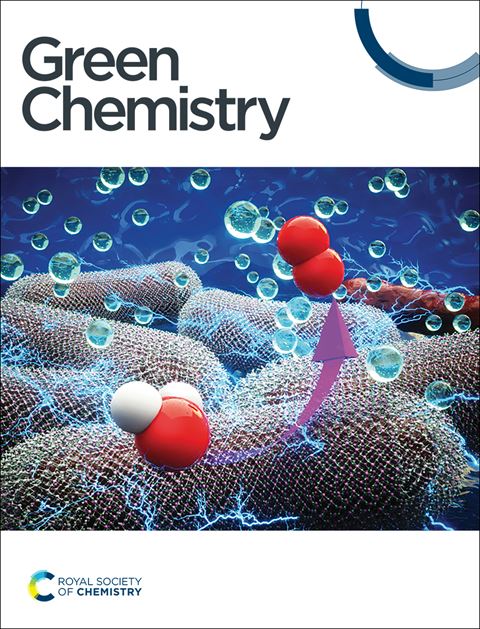Development of an integrated polyoxoniobate catalyst with oxygen activation and basicity as a green catalyst for efficient aerobic oxidation of aldehydes at room temperature†
IF 9.2
1区 化学
Q1 CHEMISTRY, MULTIDISCIPLINARY
引用次数: 0
Abstract
This work developed an inorganic–organic hybrid integrated polyoxoniobate (PONb) heterogeneous catalyst, representing the first instance of achieving efficient aldehyde oxidation using a single catalyst and clean O2 as the oxidant, without the need for high temperatures or additional co-catalysts. The catalyst exhibited excellent scalability for gram-scale reactions and proved to be recyclable. Its remarkable catalytic performance arises from the synergistic interplay of three key components within the integrated catalyst: cobalt complex cations serve as active sites for oxygen activation, Nb-oxo polyoxoanions provide Brønsted basicity, and lattice water molecules enhance efficient mass transfer across the liquid–solid interface. This integrated catalyst not only overcomes the bottleneck of low reaction efficiency in the gas–solid–liquid triphasic system for heterogeneous aerobic oxidation of aldehydes, but also provides a novel design strategy for green catalysis.

一种具有氧活化和碱性的有机多氧氧酸盐催化剂的研制,作为室温下高效好氧氧化醛的绿色催化剂
本研究开发了一种无机-有机杂化集成多氧酸盐(PONb)多相催化剂,这是首次使用单一催化剂和清洁O2作为氧化剂实现高效醛氧化,而不需要高温或额外的辅助催化剂。该催化剂在克级反应中表现出优异的可扩展性,并被证明是可回收的。其卓越的催化性能源于集成催化剂中三个关键成分的协同相互作用:钴络合阳离子作为氧活化的活性位点,nb -氧多氧阴离子提供Brønsted碱度,晶格水分子增强了液固界面的有效传质。这种一体化催化剂不仅克服了气固液三相体系反应效率低的瓶颈,而且为绿色催化提供了一种新的设计策略。
本文章由计算机程序翻译,如有差异,请以英文原文为准。
求助全文
约1分钟内获得全文
求助全文
来源期刊

Green Chemistry
化学-化学综合
CiteScore
16.10
自引率
7.10%
发文量
677
审稿时长
1.4 months
期刊介绍:
Green Chemistry is a journal that provides a unique forum for the publication of innovative research on the development of alternative green and sustainable technologies. The scope of Green Chemistry is based on the definition proposed by Anastas and Warner (Green Chemistry: Theory and Practice, P T Anastas and J C Warner, Oxford University Press, Oxford, 1998), which defines green chemistry as the utilisation of a set of principles that reduces or eliminates the use or generation of hazardous substances in the design, manufacture and application of chemical products. Green Chemistry aims to reduce the environmental impact of the chemical enterprise by developing a technology base that is inherently non-toxic to living things and the environment. The journal welcomes submissions on all aspects of research relating to this endeavor and publishes original and significant cutting-edge research that is likely to be of wide general appeal. For a work to be published, it must present a significant advance in green chemistry, including a comparison with existing methods and a demonstration of advantages over those methods.
 求助内容:
求助内容: 应助结果提醒方式:
应助结果提醒方式:


